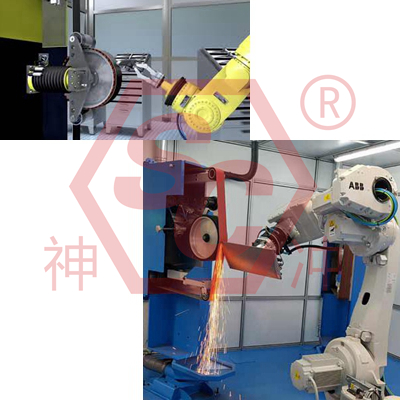
Sheet metal grinding and polishing robots can replace us to do many jobs harmful to human health, improve job security, reduce labor intensity and reduce the working hours of staff.

As a basic process in the sheet metal manufacturing industry, grinding, polishing and deburring are not only widely used, but also indispensable. In daily life, hardware, home appliance surfaces, mobile phone casings, and auto parts, it is the existence of this process that gives us a bright and bright impression.
Sheet mtela grinding, polishing and deburring is usually an intermediate process in the product production process, and it needs to deal with a variety of incoming materials such as shapes, materials, and surface conditions, as well as different grinding quality requirements.
At present, most of the domestic workpiece sheet metal grinding, polishing and deburring operations are mostly carried out by hand, or by hand-held pneumatic or electric tools for grinding, grinding, filing and other methods of deburring, which may easily lead to increased product defect rate, low efficiency, and rough surface of processed products. unevenness, etc.
The traditional manual deburring is noisy and slow, and a lot of dust will be generated during grinding, which will cause great harm to human health. Grinding materials can easily cause hand strain and injury to workers, and the dust produced by grinding is not discharged in time, which will affect production safety. Therefore, starting from the process, it is of great significance to improve the yield of the grinding process at the source.

As traditional manual methods cannot meet the needs of modern industrial production, and under the pressure of product quality, production efficiency and labor costs, the field of deburring & surface finishing technology in my country has begun to move towards customization, intelligence and automation. The transformation of the direction of grinding and polishing robots has opened a new era for the development of industrial intelligent manufacturing in my country.
Let's take a look at the application advantages of automated polishing robots.
Sheet metal polishing robot, realizing automation through programming or teaching, and a mechanical device with anthropomorphic shape and function. Engaged in surface grinding, edge deburring, welding seam grinding, inner cavity and inner hole deburring, orifice thread and chamfering, surface drawing, grinding and polishing, etc.
For humans, the greatest safety is to stay away from unsafe environments, and machine replacement plays an important role. For company property, the greatest security guarantees come from stability and controllability. One of the important features of an automated production line is safety, which means stability and controllability.
The immediate effect of robotic polishing is to replace humans in the work environment. There is a safety fence around the robot workstation, and there are matching sensors and drive control equipment inside. The entire working state is closed-loop feedback control, which is relatively safely isolated from personnel. Reduce the work intensity, ensure the safety of personnel, and improve the working environment. At the same time, due to the increased automation, the environment of the entire production site will be significantly improved in terms of dust emissions, noise control and hazard alerts.

As mentioned earlier, in the traditional manufacturing industry, polishing is the most basic process, but its cost accounts for 30% of the total cost. A polishing and grinding robot can replace 2 to 6 workers, because it can work continuously for more than 20 hours a day without any interference. Its production efficiency is also 10 to 30 times that of manual labor.
The polishing and grinding work is a repetitive work. The tedious repetitive work for the operator is precisely the favor of the robot work. The characteristics of robot grinding and polishing are to set the program, follow the rules, maintain stability, and easy to do quality control. Therefore, this will greatly improve the consistency level of product quality, reduce costs, improve efficiency, and stabilize quality. Flexible application, switching flexibility.
Compared with some special polishing machines, the application of robotic polishing is more flexible. For most small and medium-sized manufacturing enterprises, the external environment of the market requires them to follow the production model of mass production. This requires corresponding adjustments to the production line according to different order batch requirements. Changing specialized equipment in this regard requires a lot of effort. In contrast, robotic applications only require adjustment of the corresponding tools and fixtures, but no special changes to the body. Can update and switch to edit and call the corresponding program commands, which can greatly shorten the product update cycle, thereby reducing the corresponding equipment investment.
This is why robots are becoming more and more popular today. At the same time, the huge demand of small and medium-sized enterprises is a potential market for robot applications in the next five years.
Through the above introduction, I think everyone has some understanding of the application advantages of polishing robots. Robots in sheet metal production lines can replace us to do a lot of work that is harmful to human health, improve work safety, reduce labor intensity, and reduce staff working hours.